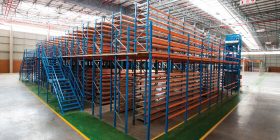It’s important to consider how each system affects your warehouse’s day-to-day workflow when deciding between rivet shelving vs. VNA racking. Rivet shelving gives you immediate access to items stored at every level, making it ideal for fast-pick environments. VNA racking, on the other hand, is built for high-volume storage in tighter spaces, where palletised stock needs to be kept efficiently and in large quantities.
Let’s explore the main features of each system, rivet shelving and VNA racking, to determine which would suit your organisation best.
Exploring the Key Features: Rivet Shelving vs. VNA Racking
Real-World Use Cases: Rivet Shelving vs. VNA Racking in Action
The practical differences between rivet shelving and VNA racking usually come down to stock variety and handling requirements. Rivet shelving allows for more hands-on picking and a variety of stock types. It suits operations with diverse SKUs and changing inventories. In contrast, VNA racking needs specialised turret trucks and works best when storing large volumes of similar items. This operational difference often defines the better fit when comparing rivet shelving and VNA racking.
Space and Flexibility: Rivet Shelving vs. VNA Racking Explained
One of the most noticeable differences between rivet shelving and VNA racking is how each uses space. Rivet shelving systems can be reconfigured quickly, allowing for layout changes as your needs shift. VNA racking is a fixed structure designed to stack pallets high and maximise vertical space. Flexibility versus density becomes the core trade-off when comparing rivet shelving and VNA racking, one prioritises adjustability, the other maximises storage capacity.
Comparing rivet shelving and VNA racking helps highlight where each system adds value—based on your space, equipment, and access needs.
Key Differences Between Rivet Shelving and VNA Racking
Understanding the differences between rivet shelving and VNA racking helps us choose what’s right. Rivet shelving can handle medium to heavy loads and allows for flexible shelf spacing. It’s great for storing open boxes or varied items you need to grab quickly. In comparison, VNA racking supports heavy pallets and stacks them high while using very little aisle space, about 2 metres wide. This layout saves floor space but requires special trucks to navigate the tight gaps.
Comparing Rivet Shelving and VNA Racking for Accessibility and Flexibility
Comparing rivet shelving and VNA racking shows clear contrasts in how each handles access and change. Rivet shelving offers direct access to every item and can be rearranged as your stock changes. That flexibility is ideal for fast-moving stock in mixed batches. VNA racking, however, is more rigid. It works best with a first-in, first-out system and depends on specialised lift equipment, which is slower for rotating items but excellent for maximising space.
Space and Cost Efficiency: Rivet Shelving vs. VNA Racking
Looking closely at rivet shelving vs. VNA racking from a cost and space view, there are practical trade-offs. VNA racking is unmatched in how it uses vertical space, which can boost capacity without growing your warehouse footprint. But this comes with higher costs for the equipment and setup. Rivet shelving, while less space-efficient, is much more affordable and easier to install or move, ideal for businesses that expect to grow or change layouts often.
Ultimately, the differences between rivet shelving and VNA racking highlight the need to prioritise your workflow, budget, and space constraints. Comparing rivet shelving and VNA racking side by side helps make a decision based on what your operation truly needs.
Understanding the Differences Between Rivet Shelving and VNA Racking
The main differences between rivet shelving and VNA racking come down to space use, access, and equipment. Rivet shelving is all about accessibility. You can walk right up to every shelf, grab what you need, and move on. No special machines or long training times. It’s a straightforward system that’s perfect for locations where quick access to varied stock is key.
VNA racking, on the other hand, focuses on stacking high and using space vertically. It works best when you have a set inventory mix and don’t need to change your setup much. The need for guided lift trucks can push the upfront costs up, but in return, you pack in more storage and improve long-term efficiency.
Comparing Rivet Shelving and VNA Racking: Practical Planning Tips
When comparing rivet shelving and VNA racking, think about more than just today’s situation. Try to look ahead. If you expect steady growth, rivet shelving is a system you can expand or move without much hassle. It’s modular and doesn’t rely on specific handling machines, so shifting it around is simple. With VNA setups, once installed, they’re harder to change. But if your layout is fixed and space is limited, the density benefits are hard to beat.
We often advise clients to weigh these factors early in the design stage. The differences between rivet shelving and VNA racking become especially clear once you map out your warehouse flow. Choose the system that gives your team the fastest and safest way to pick and restock items if you’re running a fast-paced operation.
Rivet Shelving vs. VNA Racking: Layout Decisions Matter
No two warehouses work exactly the same, so when it comes to rivet shelving vs. VNA racking, layout plays a huge role. For open floor plans where flexibility matters, rivet shelving gives you the chance to adjust quickly. It’s a good choice where teams need to collaborate, move stock manually, or access goods from all sides.
Meanwhile, VNA systems need careful aisle design and investment in guided paths for turret trucks. But if that infrastructure is already in place—or you’re planning a full redesign to make room—VNA racking can cut down on wasted aisle space while boosting overall capacity.
In the end, the key to unlocking the right fit is understanding how your storage needs and equipment work together. Comparing rivet shelving and VNA racking shouldn’t be just about hardware, it’s also about making sure the system backs up your team’s workflow and goals.
Discover the Best Shelving Solution for Your Needs
The decision between rivet shelving and VNA racking hinges on many factors, such as your workflow, storage needs, and future growth plans. As we’ve explored, each option comes with distinct advantages: rivet shelving shines in dynamic environments requiring flexibility, while VNA racking excels in maximising space and efficiency.We invite you to consult with the professionals if you’re looking to optimise your warehouse with the right shelving solutions custom-made to your unique requirements. At Krost Shelving & Racking, our team is ready to guide you through your options, ensuring your choice aligns perfectly with your operational goals. Contact us today to get started on transforming your storage space.








